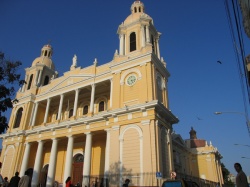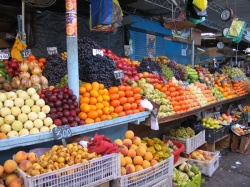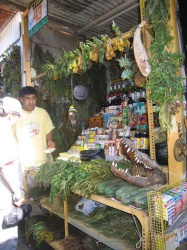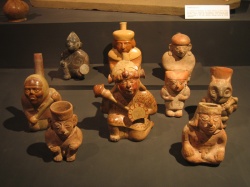Chiclayo
26 September, 2007, 08:22 pm in "Peru"
 It is with a bit of difficulty that I'm keeping Chiclayo from blurring with Piura in my mind. The cities are similar and they were separated in my mind by sleepless bus rides. We were only in Chiclayo for one day (and night). Our main purpose was visiting the Lord of Sipan museum, which is considered to be Peru's best museum. It contains the contents the Peruvian equivalent to King Tut's tomb: a rare intact tomb that wasn't robbed so had vast amounts of gold as well as other precious items.
It is with a bit of difficulty that I'm keeping Chiclayo from blurring with Piura in my mind. The cities are similar and they were separated in my mind by sleepless bus rides. We were only in Chiclayo for one day (and night). Our main purpose was visiting the Lord of Sipan museum, which is considered to be Peru's best museum. It contains the contents the Peruvian equivalent to King Tut's tomb: a rare intact tomb that wasn't robbed so had vast amounts of gold as well as other precious items. According to LP, an archaeologist noticed a sudden influx of fine pieces on the black market. He traced them and found that they were coming from graves in Sipan. Further excavation uncovered a grave that hadn't been ransacked by the Spanish or discovered by later robbers.
The museum does a wonderful job in presenting the pieces. The lighting was especially well done casting huge shadows on the floor in the shape of items displayed. The museum was designed to imitate how the tomb was (a bit like the first Tutankhamen exhibit in the 70s. The darkness made the gold pieces set with turquoise even more enticing. There were also a lot of ceramics and other pieces that were found in the tomb.
Unfortunately, even though it is internationally famous, there were hardly any explanations in English which was unfortunate because there was a lot of information about the archaeological processes done during the excavation.
There was another archaeological museum in the area with more samples of gold and ceramics as well as some ethnographic displays: a potter's and weaver's workshop, shaman ceremony and fishers. It was interesting to see that the traditional walls in the dioramas were made the same way as some that we were pulling down in Pisco: bamboo-like reeds filled with adobe.
Another interesting thing that happened in Chiclayo was we saw blue sky. Rowshan was able to take a nice photo of the church on the Plaza de Armas with blue sky in the background. It was terribly exciting.
We also took a trip to the Mercado Modelo which is huge and takes up several blocks. On the outside of it is a seemingly impermeable layer of booths selling the typical market stuff: knock-off clothing, watches, trinkets, shoes. Eventually we found a way into the interior of the market. There was a lot of fruit, clothing, household items and food.

However, the most interesting part is the "witch doctor's market". This is the section where they sell all the herbal medicine as well as interesting items needed for working spells
 .
. There were lots of fragrant fresh herbs as well as interesting dried fruits or vegetables and other plant parts. There were lots of packages which had cures for digestive problems, sexual problems, arthritis and other ailments. There were also some things that looked like love potions, religious items, and some beauty products (snail beauty cream anyone?). We stopped at one booth which had a cayman head and a dried dead skunk. The man there tried to interest me in necklaces and then offered us San Pedro's cactus.
I laughed and he opened a plastic container containing a forest green powder. He gestured to us to smell it... as if we'd be able to confirm that it really was San Pedro's cactus by the smell. It smelled like dried plant matter.
We passed him up on it. Even though I admit I'm curious about what kind of hallucinations it causes and am fascinated by the historic use, I wasn't about to experiment with strange, powerful hallucinogens offered to me by strange men in markets in foreign countries.
It is with a bit of difficulty that I'm keeping Chiclayo from blurring with Piura in my mind. The cities are similar and they were separated in my mind by sleepless bus rides. We were only in Chiclayo for one day (and night). Our main purpose was visiting the Lord of Sipan museum, which is considered to be Peru's best museum. It contains the contents the Peruvian equivalent to King Tut's tomb: a rare intact tomb that wasn't robbed so had vast amounts of gold as well as other precious items.
According to LP, an archaeologist noticed a sudden influx of fine pieces on the black market. He traced them and found that they were coming from graves in Sipan. Further excavation uncovered a grave that hadn't been ransacked by the Spanish or discovered by later robbers.
The museum does a wonderful job in presenting the pieces. The lighting was especially well done casting huge shadows on the floor in the shape of items displayed. The museum was designed to imitate how the tomb was (a bit like the first Tutankhamen exhibit in the 70s. The darkness made the gold pieces set with turquoise even more enticing. There were also a lot of ceramics and other pieces that were found in the tomb.
Unfortunately, even though it is internationally famous, there were hardly any explanations in English which was unfortunate because there was a lot of information about the archaeological processes done during the excavation.
There was another archaeological museum in the area with more samples of gold and ceramics as well as some ethnographic displays: a potter's and weaver's workshop, shaman ceremony and fishers
 .
.It was interesting to see that the traditional walls in the dioramas were made the same way as some that we were pulling down in Pisco: bamboo-like reeds filled with adobe.
Another interesting thing that happened in Chiclayo was we saw blue sky. Rowshan was able to take a nice photo of the church on the Plaza de Armas with blue sky in the background. It was terribly exciting.
We also took a trip to the Mercado Modelo which is
huge and takes up several blocks. On the outside of it is a seemingly impermeable layer of booths selling the typical market stuff: knock-off clothing, watches, trinkets, shoes. Eventually we found a way into the interior of the market. There was a lot of fruit, clothing, household items and food. However, the most interesting part is the "witch doctor's market". This is the section where they sell all the herbal medicine as well as interesting items needed for working spells. There were lots of fragrant fresh herbs as well as interesting dried fruits or vegetables and other plant parts. There were lots of packages which had cures for digestive problems, sexual problems, arthritis and other ailments. There were also some things that looked like love potions, religious items, and some beauty products (snail beauty cream anyone?).
We stopped at one booth which had a cayman head and a dried dead skunk. The man there tried to interest me in necklaces and then offered us San Pedro's cactus.
I laughed and he opened a plastic container containing a forest green powder. He gestured to us to smell it... as if we'd be able to confirm that it really was San Pedro's cactus by the smell. It smelled like dried plant matter.
We passed him up on it. Even though I admit I'm curious about what kind of hallucinations it causes and am fascinated by the historic use, I wasn't about to experiment with strange, powerful hallucinogens offered to me by strange men in markets in foreign countries.
[ View 1 Comments
|
]
Comments
Mom -
posted on 10/11/2007
Hi-editing note-you,ve got the content doubled here. But all these different adventures are so very interesting the are worth reading twice!
Powered by My Blog 1.69. Copyright 2003-2006 FuzzyMonkey.net.
Created by the scripting wizards at FuzzyMonkey.net..
(Code modified by Rowshan Dowlatabadi)
Created by the scripting wizards at FuzzyMonkey.net..
(Code modified by Rowshan Dowlatabadi)

